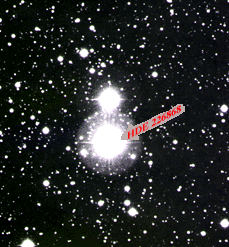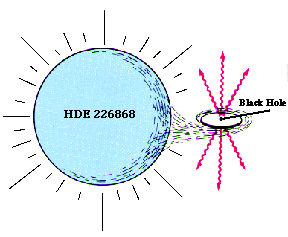|
|
 |
|
On this page, I'll tell you all about BLACK HOLE and its profiles.
|
 |
|
What is a black hole?
A black hole is a region of spacetime from which nothing can escape, even light.
To see why this happens, imagine throwing a tennis ball into the air. The harder you throw the tennis ball, the faster
it is travelling when it leaves your hand and the higher the ball will go before turning back. If you throw it hard enough
it will never return, the gravitational attraction will not be able to pull it back down. The velocity the ball must have
to escape is known as the escape velocity and for the earth is about 7 miles a second.
As a body is crushed into a smaller and smaller volume, the gravitational attraction increases, and hence the escape velocity
gets bigger. Things have to be thrown harder and harder to escape. Eventually a point is reached when even light, which travels
at 186 thousand miles a second, is not travelling fast enough to escape. At this point, nothing can get out as nothing can
travel faster than light. This is a black hole.
Further Explanation
 If a planet moves around the sun in a circular orbit of radius r at speed v, then the mass M of the sun is given by

where G is a gravitational constant. If we can measure speed and size of orbit, we can estimate the mass of the central object. For our sun it is about
2,000,000,000,000,000,000,000,000,000,000 kg.
Most solar systems are elliptical rather than circular. The principle's the same, but the arithmetic is harder!
The universe is expanding, and so most objects are receding from us. By measuring the redshift we can find out how fast they are moving away.
Cosmological models predict a definite relation between speed and distance; for nearby objects, distance is proportional
to speed. This makes it straightforward to decide the distance of say a galaxy.
For objects which are not too far away (and not too small) the difference in angular direction between one boundary and
another is directly proportional to its size:
size = angular separation x distance.
|
 |
|
Do they really exist?
It is impossible to see a black hole directly because no light can escape from them; they are black. But there are good
reasons to think they exist.
When a large star has burnt all its fuel it explodes into a supernova. The stuff that is left collapses down to an extremely
dense object known as a neutron star. We know that these objects exist because several have been found using radio telescopes.
If the neutron star is too large, the gravitational forces overwhelm the pressure gradients and collapse cannot be halted.
The neutron star continues to shrink until it finally becomes a black hole. This mass limit is only a couple of solar masses,
that is about twice the mass of our sun, and so we should expect at least a few neutron stars to have this mass. (Our sun
is not particularly large; in fact it is quite small.)
A supernova occurs in our galaxy once every 300 years, and in neighbouring galaxies about 500 neutron stars have been identified.
Therefore we are quite confident that there should also be some black holes.
|
 |
 |
 |
|
Particles of light, called photons, move faster than any other object with a speed of three hundred million metres per
second. In one year they move a distance
9,500,000,000,000 kilometres,
which is called a light year.
If we see light coming from a distant source one million light years away, we are seeing the object not as it is now, but how it was one million years ago.
|
|
 |
 |
 |
|
|
|
|
|
Express trains usually sound their horns as they pass through stations at which they do not stop. Passengers
on the platform hear a higher note as the train approaches and a lower one as it recedes. The difference in frequency is proportional
to the speed of the train. Physicists call this the Doppler effect.
The same effect happens with light. If a star is approaching us it appears bluer, and if it is receding it
appears redder. The shift in frequency, usually called the redshift, is proportional to the speed at which it is moving away
from us.
If We Can't See Them, How Do We Know They're There?

Since black holes are small (only a few to a few tens of kilometers in size), and light that would allow us
to see them cannot escape, a black hole floating alone in space would be hard, if not impossible, to see. For instance, the
photograph above shows the optical companion star to the (invisible) black hole candidate Cyg X-1.
However, if a black hole passes through a cloud of interstellar matter, or is close to another "normal" star, the black hole can accrete matter into itself. As the matter falls or is pulled towards the black hole, it gains kinetic energy, heats
up and is squeezed by tidal forces. The heating ionizes the atoms, and when the atoms reach a few million degrees Kelvin, they emit X-rays. The X-rays are sent off into space before the matter crosses the Schwarzschild radius and crashes into the
singularity. Thus we can see this X-ray emission.
Binary X-ray sources are also places to find strong black hole candidates. A companion star is a perfect source
of infalling material for a black hole. A binary system also allows the calculation of the black hole candidate's mass. Once the mass is found, it can be determined
if the candidate is a neutron star or a black hole, since neutron stars always have masses of about 1.5 times the mass of the sun. Another sign
of the presence of a black hole is random variation of emitted X-rays. The infalling matter that emits X-rays does not fall
into the black hole at a steady rate, but rather more sporadically, which causes an observable variation in X-ray intensity.
Additionally, if the X-ray source is in a binary system, the X-rays will be periodically cut off as the source is eclipsed by the companion star. When looking for black hole candidates, all these things are taken into account. Many
X-ray satellites have scanned the skies for X-ray sources that might be possible black hole candidates.
Cygnus X-1 is the longest known of the black hole candidates. It is a highly variable and irregular source
with X-ray emission that flickers in hundredths of a second. An object cannot flicker faster than the time required for light
to travel across the object. In a hundredth of a second, light travels 3000 kilometers. This is one fourth of Earth's diameter! So the region emitting the x-rays around
Cygnus X-1 is rather small. Its companion star, HDE 226868 is a B0 supergiant with a surface temperature of about 31,000 K.
Spectroscopic observations show that the spectral lines of HDE 226868 shift back and forth with a period of 5.6 days. From the mass-luminosity relation, the mass of this supergiant is calculated as 30 times the mass of the Sun. Cyg X-1 must have a mass
of about 7 solar masses or else it would not exert enough gravitational pull to cause the wobble in the spectral lines of
HDE 226868. Since 7 solar masses is too large to be a white dwarf or neutron star, it must be a black hole.

However, there are arguments against Cyg X-1 being a black hole. HDE 2268686 might be undermassive for its
spectral type, which would make Cyg X-1 less massive than previously calculated. In addition, uncertainties in the distance
to the binary system would also influence mass calculations. All of these uncertainties can make a case for Cyg X-1 having
only 3 solar masses, thus allowing for the possibility that it is a neutron star.
Nonetheless, there are now about 10 binaries for which the evidence for a black hole is much stronger than
in Cygnus X-1. The first of these, an X-ray transient called A0620-00, was discovered in 1975, and the mass of the compact
object was determined in the mid-1980's to be greater than 3.5 solar masses. This very clearly excludes a neutron star, which
has a mass near 1.5 solar masses, even allowing for all known theoretical uncertainties. The best case for a black hole is
probably V404 Cygni, whose compact star is at least 10 solar masses. With improved instrumentation, the pace of discovery
has accelerated over the last five years or so, and the list of dynamically confirmed black hole binaries is growing rapidly.
..::A place for those BLACK HOLE lover::..
|
|
|
 |

